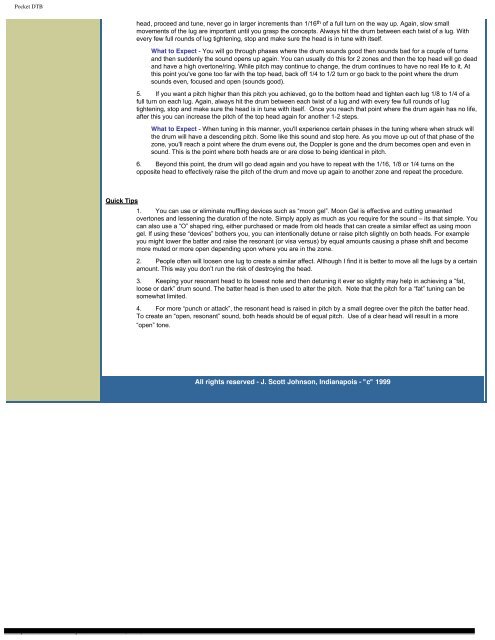Drum tuning bible
Drum tuning bible
Drum tuning bible
- No tags were found...
Create successful ePaper yourself
Turn your PDF publications into a flip-book with our unique Google optimized e-Paper software.
Pocket DTBhead, proceed and tune, never go in larger increments than 1/16 th of a full turn on the way up. Again, slow smallmovements of the lug are important until you grasp the concepts. Always hit the drum between each twist of a lug. Withevery few full rounds of lug tightening, stop and make sure the head is in tune with itself.What to Expect - You will go through phases where the drum sounds good then sounds bad for a couple of turnsand then suddenly the sound opens up again. You can usually do this for 2 zones and then the top head will go deadand have a high overtone/ring. While pitch may continue to change, the drum continues to have no real life to it. Atthis point you've gone too far with the top head, back off 1/4 to 1/2 turn or go back to the point where the drumsounds even, focused and open (sounds good).5. If you want a pitch higher than this pitch you achieved, go to the bottom head and tighten each lug 1/8 to 1/4 of afull turn on each lug. Again, always hit the drum between each twist of a lug and with every few full rounds of lugtightening, stop and make sure the head is in tune with itself. Once you reach that point where the drum again has no life,after this you can increase the pitch of the top head again for another 1-2 steps.What to Expect - When <strong>tuning</strong> in this manner, you'll experience certain phases in the <strong>tuning</strong> where when struck willthe drum will have a descending pitch. Some like this sound and stop here. As you move up out of that phase of thezone, you'll reach a point where the drum evens out, the Doppler is gone and the drum becomes open and even insound. This is the point where both heads are or are close to being identical in pitch.6. Beyond this point, the drum will go dead again and you have to repeat with the 1/16, 1/8 or 1/4 turns on theopposite head to effectively raise the pitch of the drum and move up again to another zone and repeat the procedure.Quick Tips1. You can use or eliminate muffling devices such as “moon gel”. Moon Gel is effective and cutting unwantedovertones and lessening the duration of the note. Simply apply as much as you require for the sound – its that simple. Youcan also use a “O” shaped ring, either purchased or made from old heads that can create a similar effect as using moongel. If using these “devices” bothers you, you can intentionally detune or raise pitch slightly on both heads. For exampleyou might lower the batter and raise the resonant (or visa versus) by equal amounts causing a phase shift and becomemore muted or more open depending upon where you are in the zone.2. People often will loosen one lug to create a similar affect. Although I find it is better to move all the lugs by a certainamount. This way you don’t run the risk of destroying the head.3. Keeping your resonant head to its lowest note and then de<strong>tuning</strong> it ever so slightly may help in achieving a “fat,loose or dark” drum sound. The batter head is then used to alter the pitch. Note that the pitch for a “fat” <strong>tuning</strong> can besomewhat limited.4. For more “punch or attack”, the resonant head is raised in pitch by a small degree over the pitch the batter head.To create an “open, resonant” sound, both heads should be of equal pitch. Use of a clear head will result in a more“open” tone.All rights reserved - J. Scott Johnson, Indianapois - "c" 1999http://home.earthlink.net/~prof.sound/id15.html (3 of 3)1/22/2005 4:11:05 PM


